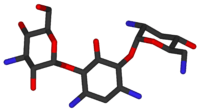Tobramycin
 | |
|---|---|
 | |
| Systematic (IUPAC) name | |
| (2S,3R,4S,5S,6R)-4-amino-2-{[(1S,2S,3R,4S,6R)-4,6-diamino-3-{[(2R,3R,5S,6R)-3-amino-6-(aminomethyl)-5-hydroxyoxan-2-yl]oxy}-2-hydroxycyclohexyl]oxy}-6-(hydroxymethyl)oxane-3,5-diol | |
| Clinical data | |
| Trade names | Tobrex |
| AHFS/Drugs.com | monograph |
| MedlinePlus | a682660 |
| Pregnancy cat. | D (Injection, Inhalation); B (Ophthalmic) (US) |
| Legal status | ? |
| Routes | IV, IM, inhalation, ophthalmic |
| Pharmacokinetic data | |
| Protein binding | < 30% |
| Identifiers | |
| CAS number | 32986-56-4 |
| ATC code | J01GB01 S01AA12 |
| PubChem | CID 36294 |
| DrugBank | DB00684 |
| ChemSpider | 33377 |
| UNII | VZ8RRZ51VK |
| KEGG | D00063 |
| ChEBI | CHEBI:28864 |
| ChEMBL | CHEMBL1747 |
| Chemical data | |
| Formula | C18H37N5O9 |
| Mol. mass | 467.515 g/mol |
| SMILES
| |
| |
| | |
Tobramycin is an aminoglycoside antibiotic derived from Streptomyces tenebrarius and used to treat various types of bacterial infections, particularly Gram-negative infections. It is especially effective against species of Pseudomonas.[1]
Mechanism of action
Tobramycin works by binding to a site on the bacterial 30S and 50S ribosome, preventing formation of the 70S complex. As a result, mRNA cannot be translated into protein and cell death ensues. Tobramycin is preferred over gentamicin for Pseudomonas aeruginosa pneumonia due to better lung penetration.[citation needed]
Administration and indications
Like all aminoglycosides, tobramycin does not pass the gastro-intestinal tract, so for systemic use it can only be given intravenously or intramuscularly. Ophthalmic (tobramycin only, Tobrex, or combined with dexamethasone, sold as TobraDex) and nebulised formulations both have low systemic absorption. The formulation for injection is branded Nebcin. The nebulised formulation (brand name Tobi) is indicated in the treatment of exacerbations of chronic infection with Pseudomonas aeruginosa in patients diagnosed with cystic fibrosis. A proprietary formulation of micronized, nebulized tobramycin has been tested as a treatment for bacterial sinusitis.[2] Tobrex is a 0.3% tobramycin sterile ophthalmic solution is produced by Bausch & Lomb Pharmaceuticals. Benzalkonium chloride 0.01% is added as a preservative. It is available by prescription only in the United States and Canada. In certain countries, such as Italy, it is available over the counter. Tobrex and TobraDex are indicated in the treatment of superficial infections of the eye, such as bacterial conjunctivitis. Tobramycin (injection) is also indicated for various severe or life-threatening gram-negative infections: meningitis in neonates, brucellosis, pelvic inflammatory disease, Yersinia pestis infection (plague).[citation needed]
Side effects
Like other aminoglycosides, tobramycin is ototoxic: it can cause hearing loss, or a loss of equilibrioception, or both in genetically susceptible individuals. These individuals carry a normally harmless genetic mutation that allows aminoglycosides such as tobramycin to affect cochlear cells. Aminoglycoside-induced ototoxicity is generally irreversible.
As with all aminoglycosides, tobramycin is also nephrotoxic, meaning it is toxic to the kidneys. This effect can be particularly worrisome when multiple doses accumulate over the course of a treatment or when the kidney concentrates urine by increasing tubular reabsorption during sleep. Adequate hydration may help prevent excess nephrotoxicity and subsequent loss of renal function. For these reasons parenteral tobramycin needs to be carefully dosed by body weight, and its serum concentration monitored. Tobramycin is thus said to be a drug with a narrow therapeutic index.
References
- ↑ "Tobramycin" (pdf). Toku-E. 2010-01-12. Retrieved 2012-06-11.
- ↑ "Nebulized Tobramycin in treating bacterial Sinusitis" (Press release). July 22, 2008. Retrieved 2009-12-06.
External links
- Tobramycin bound to proteins in the PDB
| ||||||||||||||||||||||||||||||||||||||||||||||||||||||||||